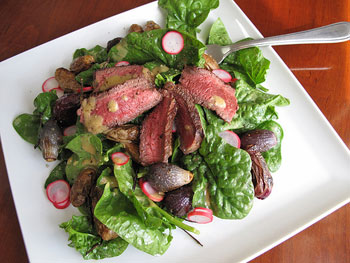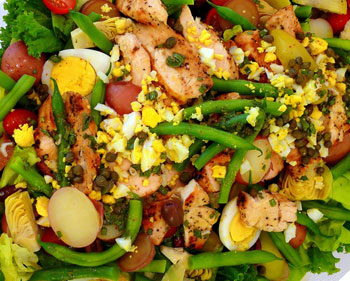 Spring brings many colorful bounties, but the best of the season comes in green. This time of year farmers' markets are brimming with tender, young vegetables. That's why my friend Caroline and I decided to take a trip to the Union Square Greenmarket this past week to see what dish we could create together.
Spring brings many colorful bounties, but the best of the season comes in green. This time of year farmers' markets are brimming with tender, young vegetables. That's why my friend Caroline and I decided to take a trip to the Union Square Greenmarket this past week to see what dish we could create together.
With all the beautiful salad greens available at the market, we naturally decided upon making a salad. After browsing all the produce to see what was the freshest and most appealing, we found some beautiful spinach for our base. We also gathered baby fingerling potatoes, baby red onions, and radishes. Caroline had the perfect idea, to flash pickle the radishes. And for a lean protein, I suggested a steak, which we picked up at the nearby Whole Foods Market. Once we had all our ingredients, we were ready to cook—and eat.
What we achieved was a colorful and healthy salad with a combination of earthy vegetables that encapsulated the flavors of spring.

 As the sun rises over the chain of glacier-formed lakes, I revel in the beauty outside my window and the smells and sounds outside my door. It is so beautiful I want to take this moment to tell you about it. The beavers swim by half an hour before sunrise on their way to work and this doesn’t include freeway commuting, just a gentle swim to their hut nearly a quarter mile away. Then all the birds start their morning songs, the Osprey flies by casting a coppery shadow across my ceiling as the sun starts to rise. The loons are soulfully singing in the near distance and a single loon fishes diligently in the cove. It promises to be an even more beautiful day than yesterday. Spring is springing in all its glory!
As the sun rises over the chain of glacier-formed lakes, I revel in the beauty outside my window and the smells and sounds outside my door. It is so beautiful I want to take this moment to tell you about it. The beavers swim by half an hour before sunrise on their way to work and this doesn’t include freeway commuting, just a gentle swim to their hut nearly a quarter mile away. Then all the birds start their morning songs, the Osprey flies by casting a coppery shadow across my ceiling as the sun starts to rise. The loons are soulfully singing in the near distance and a single loon fishes diligently in the cove. It promises to be an even more beautiful day than yesterday. Spring is springing in all its glory! Well, I am embarrassed to admit that I got overwhelmed in Whole Foods the other day. Here I am a Food Professional (whatever that is), and the sheer abundance of goodies in the store was just too much for me. Granted, it was a quick stop—I only had 10 minutes to troll the store, as I was on my way to a book signing at
Well, I am embarrassed to admit that I got overwhelmed in Whole Foods the other day. Here I am a Food Professional (whatever that is), and the sheer abundance of goodies in the store was just too much for me. Granted, it was a quick stop—I only had 10 minutes to troll the store, as I was on my way to a book signing at  It’s almost Spring, right? All the beautiful produce will start showing up at the market soon. This salad is a beautiful addition to any table, making a beautiful centerpiece for a stunning buffet.
It’s almost Spring, right? All the beautiful produce will start showing up at the market soon. This salad is a beautiful addition to any table, making a beautiful centerpiece for a stunning buffet. Los Angeles is shedding its winter coat, the birds are singing; Spring has boinged in like Zebedee. The farmers markets are jam-packed with citrus, strawberries, golden beets and asparagus.
Los Angeles is shedding its winter coat, the birds are singing; Spring has boinged in like Zebedee. The farmers markets are jam-packed with citrus, strawberries, golden beets and asparagus.